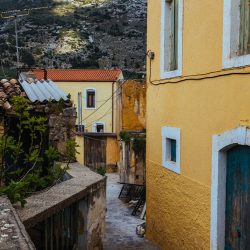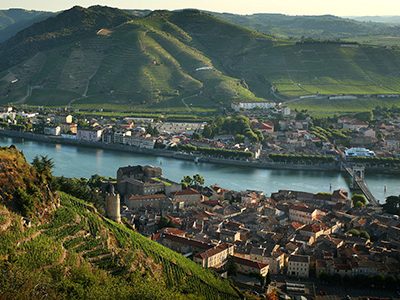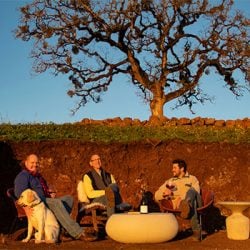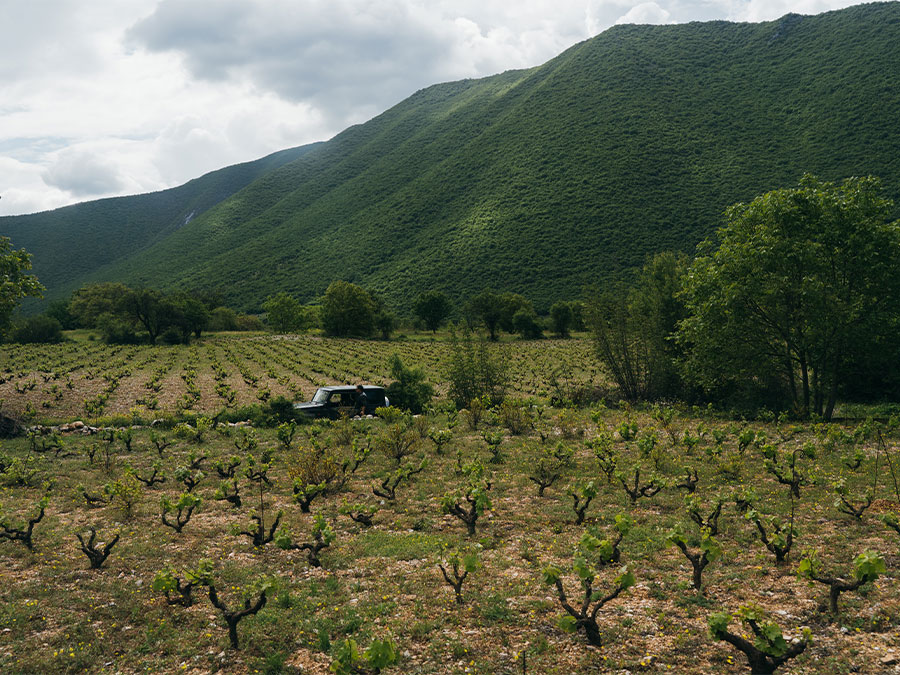

Dimítrios Diamantís poured me a taste of his Magoútes Vineyards Xinómavro, then excused himself to take a call. He was only a minute, and when he got off the phone he had good news to share. I had met him in his tasting room in Siátista, in the mountains of western Macedonia, 40 miles from Greece’s northern border. With vineyards climbing from 2,500 to 3,000 feet in altitude, Siátista was a prominent wine region for centuries but has seen its production shrink by over 80 percent, and now even wine lovers from within Greece are often hard-pressed to find it on a map.
Siátista has not been granted a Protected Denomination of Origin (PDO), a status equivalent to a French AOC or an Italian DOCG and given by the EU to Náoussa, along with Gouménissa, Amíndeo and Rapsáni, four regions in Greece that also work with xinómavro. Instead, Siátista offers its own distinct style of xinómavro as a Protected Geographical Indication (PGI)—an underdog status it shares with nearby Velvendós. Currently, there are just three commercial producers working in these two regions. But, historically, that was not always the case.
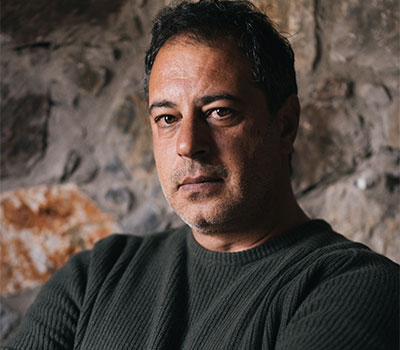

A third-generation vigneron, Dimítrios Diamantís is racing against time to preserve Siátista’s vineyards for the next generation to come.
This xinómavro from Siátista has little of the power or density the variety offers in Náoussa, 40 miles east and more than 2,000 feet below. In those lower altitudes, you might find concentrated wines redolent of tomato paste, tomato leaf and black olive. Here, in the mountains, xinómavro sings in a higher register, a clean, piercing note of cherries and fractured limestone, textured with fine, chalky tannins. When I first came here in 2019, it was a bit by chance; I’ve returned because I find the region’s signature on one of Greece’s flagship grape varieties distinctive and irresistible.
Diamantís is jubilant—the phone call was a handshake on a deal to buy one stremma (0.1 hectares or .247 acres) of old xinómavro vines, along with planting rights for another 4.9 acres. For years, he’s been working to purchase abandoned vineyards as well as planting rights, and his time is running short. As of July 2023, growers in Siátista will lose their planting rights if they are not making commercial wine from their grapes or selling them under contract. That lost surface area will be allocated to other wine regions in Greece. Where there once were 4,000 acres of vines in Siátista, there are now 740, a lot of them abandoned. Diamantís’s father, Konstantínos, who inherited a single acre of vines, started building the family’s vineyard holdings in the 1980s. Dimítrios has made that his chosen purpose for the past 15 years, piecing together roughly 110 acres, and renting another ten.
Siátista’s vineyards cover the south-facing slopes below town, then take a left turn to continue up the western side of a narrow, closed-ended valley that puts one in mind of a combe in Burgundy. There are hundreds of tiny contiguous parcels that have been subdivided dozens of times through inheritance over the centuries. At any number of abandoned plots, Diamantís’s efforts have come to nothing because either the owners can’t be found, or the many co-owners can’t reach consensus on a contract.
So, his additions to the Magoútes Vineyards estate come in miniscule increments. And Diamantís is constantly closing deals. On another visit a few years ago, as we walked in an old, ungrafted parcel showing signs of past propagation by provignage, he told me he’d just acquired it recently. I asked when: “Yesterday.”


The story of Siátista starts at the foot of Mount Voúrinos. Anna Bátsi, a geologist with the UNESCO Geopark that includes Siátista, told me the 6,122-foot peak “used to be the Triassic shoreline of Europe.” The sea left a crumble of limestone that reaches more than 30 feet below the surface, where the rock’s 160-million-year decomposition lets the vines send roots quite deep with ease. Perhaps this is why, despite xinómavro being a relatively vigorous and prolific variety, the vines don’t tend to exhibit hydric stress. There’s no topsoil to speak of, and consequently little to no need to battle weeds. A common practice is just to do a shallow hoeing in a circle around each vine at pruning time, and that’s mostly to inhibit rot in the vines’ upper roots.
The weather here is radically different from that of most of Greece. It’s late April on this visit, and I was wearing a t-shirt and sandals the day before in Athens; today in Siátista, it’s jeans and boots, hoodie and coat, even though it’s mostly sunny out. Winters see less snow than they did 20 years ago, but are quite cold, followed by good spring rains and a mild summer featuring 30 degrees’ Fahrenheit diurnal temperature variation. There is some hail in June (interestingly, unaltered in recent decades, even as the planet’s climate changes), but not catastrophic. A wind reliably flows down from the north, keeping the vines both cool and ventilated. Whereas September used to bring rainy days, now it is typically dry and sunny, encouraging ideal polyphenol development in the grape skins before harvest in October, minus an annual tithe exacted by birds, boars and black bears coming out of the surrounding woods.
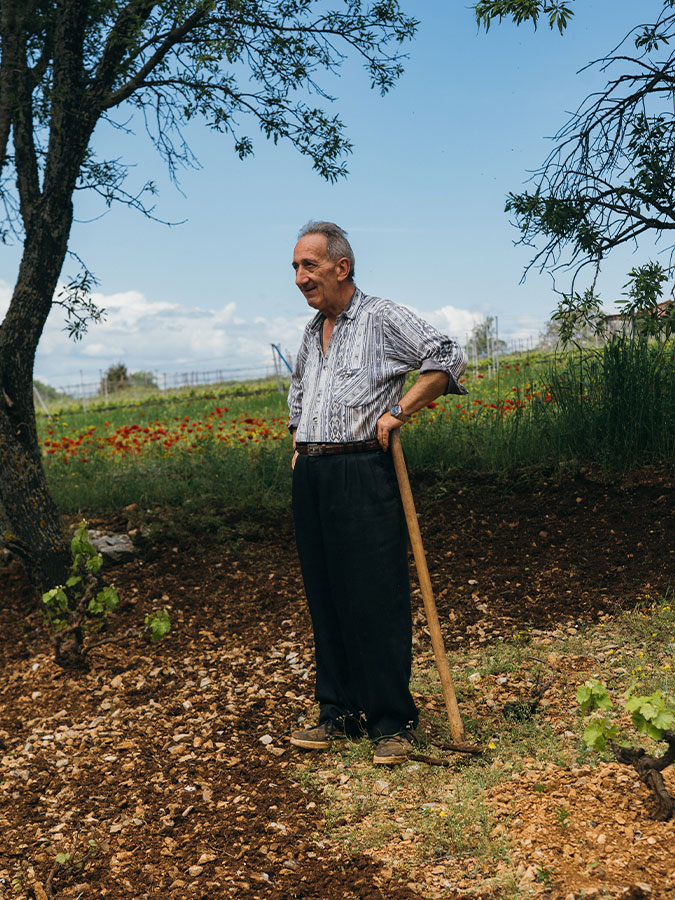

Diamantís told me that Siátistans began to abandon their ancestral vineyards during Greek Civil War, from 1946 to ’49, a dangerous time to be out in the fields. Just as villagers all across Europe were flocking to the larger cities for work after the Second World War, so did Siátistans, with the added incentive of greater safety.
Before four decades of war (the First and Second Balkan Wars from 1912–13, the First and Second World Wars, and finally the Greek Civil War), and before the arrival of phylloxera in the late 1920s, the quality of Siátistan wine was known to Western Europe. The English colonel and spy William Martin Leake observed on his travels in 1805 that “the Siátistans make some of the best wine in Rumilí [the Ottoman province that comprised northern Greece and southern Bulgaria], and which has an extensive sale in Macedonia and Thessaly.” The following year, François Pouqueville, Napoleon’s consul at the court of Ali Pasha in Ioánnina, traveled through Siátista and noted that the town’s wines “are equally renowned and, in my opinion, the best in Macedonia,” a sentiment echoed thirty-five years later by his countryman, Ami Boué. Ottoman tax records indicate that the wines from around Siátista and Velvendós commanded high prices from at least the 16th century, as they were known for their quality.
In the 1950s, Siátista’s proximity to Albania and the northerly trade route through its mountains encouraged the locals who remained to turn from viticulture to furs. While Siátista and Kastoriá, some 20 miles northwest, had been active in fur production for centuries, the industry had long been dominated by Jewish traders in Russia. But that community was wiped out in the 20th century, first by tsarist pogroms and later by massacre and eviction at the hands of Josef Stalin. By the mid-century, fur traders in Siátista and Kastoriá stepped into the vacuum, raising minks on an industrial scale and sending their pelts north on the highway through the Balkans to Central and Eastern Europe.
It was a lucrative business, and it’s not shocking that the townsfolk, now flush with mink wealth, opted to forgo the work of tending bush vines a handspan or two off the ground. As is often the case in the annals of wine history, century-old vines on the steepest, rockiest hillsides were the most likely to be abandoned, as they required the most intensive work, and delivered the lowest yields.
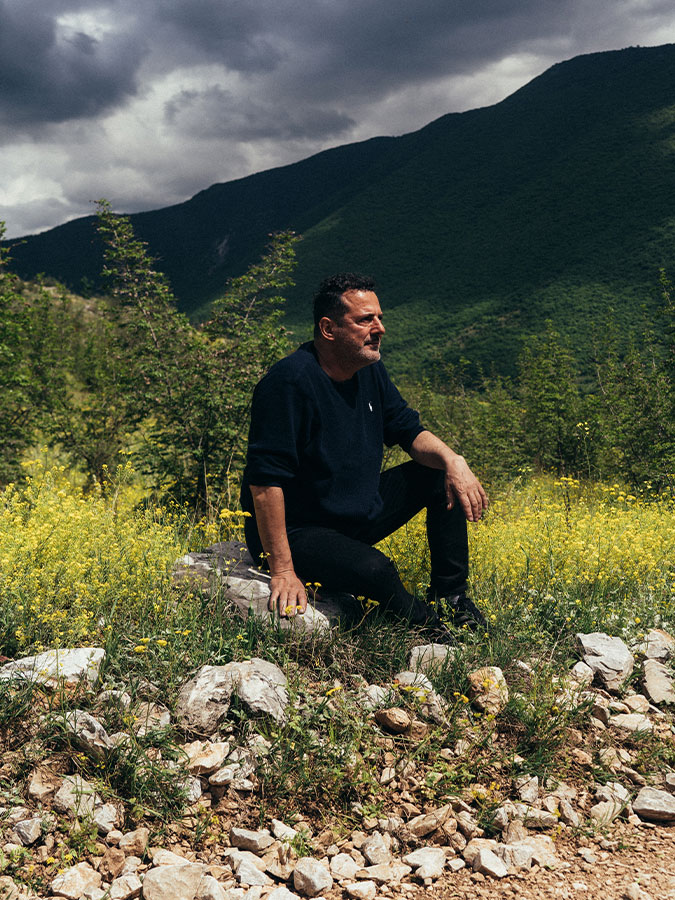

When Konstantínos Diamantís began buying up small plots around Siátista in the 1980s, his goal was to rescue old selections of xinómavro, as well as moschómavro, a small-berried, thin-skinned variety formally identified by the Greek government at Konstantínos’s urging; it’s often a blending component in the wines of Siátista, where it adds brightness and spice. Yet, his main occupation was in the fur trade. By the late ’90s, Konstantínos had collected 17 acres of vines but did not start making wine under his own label until 2002. His son Dimítrios, who had also worked in crafting furs and in their sale internationally, took over at the winery when his father died in 2008. Five years later, he left the fur trade for good, committing fully to the vineyards and cellar.
While the Diamantís family has been largely focused on the red wines of Siátista, Georgía Goutziamánis and her husband, Giánnis Polízos, established the town’s other winery, Dío Fíli, where the signature wine is a sweet one. With 37 acres to their name and contracts on another 44.5, they work with the local red varieties—xinómavro, moschómavro and nigrikiótiko; on the advice of friend and former business partner, Yiánnis Boutáris, they began working with a wide range of varieties new to the region, including assyrtiko, chardonnay, pinot noir, sauvignon and gewurztraminer. The couple’s approach is a modern one in most respects; the exception is their sweet Liastós, a rare specialty of Siátista, and as old-school as they come.
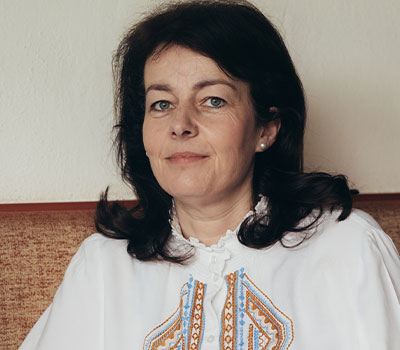

At Dío Fíli, in Siátista, Georgia Goutziamánis works to maintain her family’s long tradition of Liastós wine.
Like Vinsanto from Santorini, Liastós wine is made from dried grapes. Also like Vinsanto, it was a commodity with a strong export trade, sending barrels by cart to imperial Russia. That drying at one point would occur under the sun’s rays (meaning “be-sunned,” Liastós ultimately comes from hélios, “sun” in Ancient Greek). Lately, the xinómavro and moschómavro grapes shed 85 percent of their weight through slow osmosis over the course of 60 days or more in wooden trays lining the walls of the old cellar. Polízos ferments the wine in small barrels in the 180-year-old Goutziamánis family cellar that is devoted to Liastós (the dry wines are made in a newer facility down the street). And that fermentation proceeds on a stop-and-start pace for a year or more. Their 2008 vintage contains a small percentage of much older stock recovered from larger barrels coopered on site by Goutziamánis’s ancestors, as the doorway could not accommodate their girth. A wine that lasts on the breath for minutes, with successive waves of stewed fruits interwoven with flavors of toffee and balsamic spice, it could be an imagined marriage between a fine Recioto della Valpolicella and an old Bual Madeira. It’s not hard to see why, over 200 years ago, Col. Leake singled this style out for particular praise.
While Diamantís also makes a brilliant Liastós, it is his dry wines that are undergoing seismic change, all with an eye to letting Siátista’s particular ancestral vine material and the area’s unique soil signature speak clearly, unimpeded by overt oak influence. Over the past several years, Diamantís has been phasing out barriques and 550-liter barrels in favor of larger vessels. In the new winery, still under construction, a row of ten 2,500-liter Slavonian-oak botti have arrived from Stockinger in Austria, joining even larger tulip-shaped fermenters made of unlined concrete, untoasted French oak tini, and one 800-liter clay amphora. Most of his winery space will be devoted to aging xinómavro, with a goal of 12 to 16 months in botti, and then five to ten years in bottle prior to release. The scale of the vision and of the new facility is massive, and it’s made possible by Diamantís’s business partner since 2018, Giórgos Papageorgíou, a native of Siátista who is injecting a fortune made in the fur trade into a variety of projects around his hometown, from energy-producing windmills to preserving the area’s viticultural heritage.
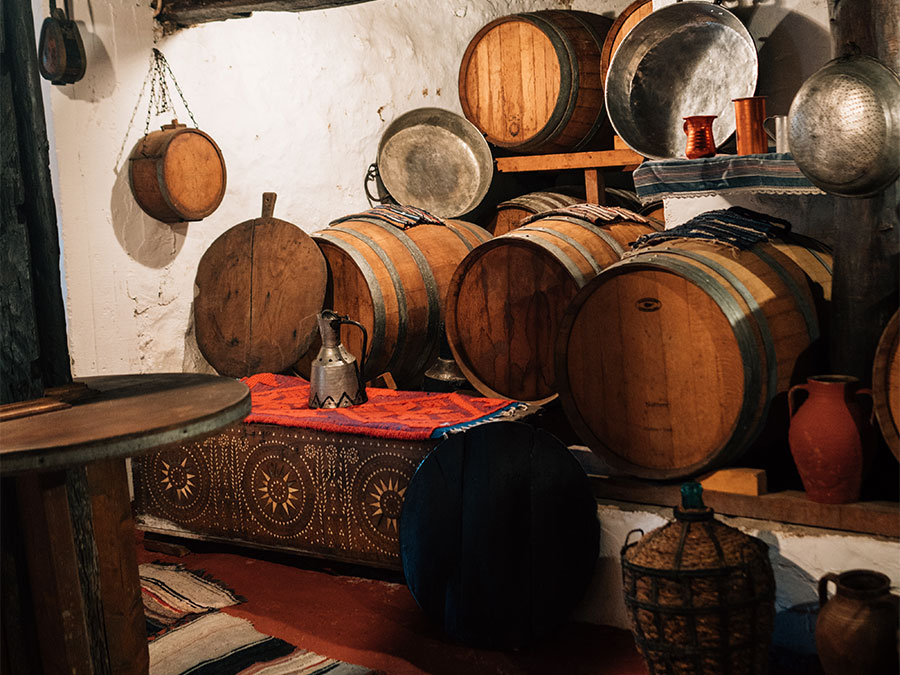

The elevations are lower 22 miles to the east in Velvendós (1,250 feet), where the vineyard exodus was more recent: In 1973, the military junta then running Greece built a hydroelectric dam on the Aliákmonas River, sinking the valley’s villages and vines under the waters of the new Lake Polyphytou. It now takes an hour to drive from Siátista (…or an hour and a half when the bridge is closed, as it was for my visit). Though there were once 250 acres of vines in Velvendós, the appellation now is limited to 100 acres, created by villagers who didn’t join a mass exodus, instead reestablishing homes and vines higher up the slopes of the surrounding mountains, taking cuttings from their old vineyards with them.
Lake Polyphytou, a long, narrow reservoir covering over 18,000 acres and reaching a depth of 500 feet, has spawned a major fishing industry (with fish topping 200 pounds). It has also gentled the climate for the pear and peach orchards and vineyards lining its southeastern shore. Winemaker Yánnis Voyatzís explained that the mass of water has changed the air circulation patterns in the area, interrupting the flow of cold northern air in the winter, and then absorbing heat during the summer. During the growing season, breezes off the water serve to keep the vines well ventilated.
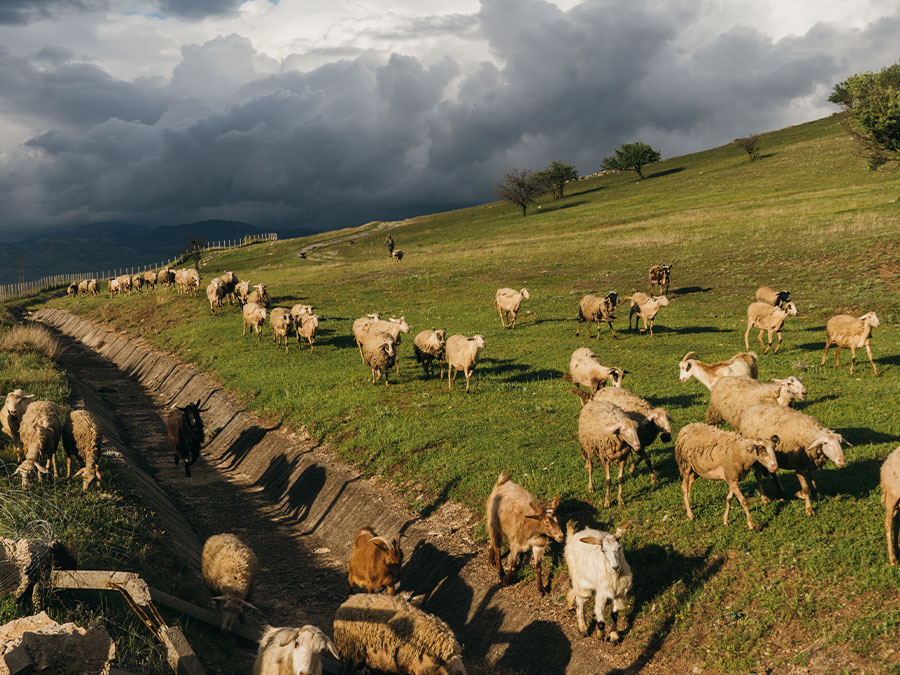

The young Voyatzís got his first taste of Velvendós wine and tsípouro (Greek grappa) at his father’s tavern in nearby Kateríni, before the damming of the river. He studied chemistry in Thessaloníki, then oenology in Bordeaux before he landed as winemaker at Boutári in 1984. Nearly 40 years later, he still leads the winemaking team there as CEO, while also running his own winery in Velvendós. (When asked how he juggles those responsibilities, a sheepish “Badly” is his answer.) A relentless tinkerer, Voyatzís planted a study vineyard to play around with vines propagated from the material rescued from the flood, eventually identifying a clone of xinómavro that he believes is unique to Velvendós. Through this work, he succeeded in getting monopole PGI status for his estate in 2000, which is also planted with selections from the old vineyards of moschómavro and Velvendós’s specialty, tsapournákos.
For eight years, Voyatzís experimented with this local oddity, intrigued by its distinctive peppery character not found in other western Macedonian wines. When genetic analyses by the University of Conegliano in Italy, and ENTAV in France revealed that tsapournákos is, in fact, cabernet franc, the mystery became, instead, what had brought it to the mountains of northern Greece. It’s very possible that it arrived in the 1920s, along with ethnically Greek refugees from the Balkans. Phylloxera had hit these areas earlier than Greece, and this influx included a large number of skilled vine grafters. Had they arrived in Greece earlier, Siátista’s fortunes might have been different; what seems likely is that they brought cabernet franc, aka tsapournákos, with them.
Tsapournákos in Velvendós gives a wine that is very different from cabernet franc bottlings from Chinon, Bourgueil, Saumur or Bordeaux. The structure is more compact, the acid less spiky, the wine less fleshy in its fruit. The rich, loamy soils here, the narrow diurnal temperature shift imposed by the lake, and the élevage in barriques leave similar a stamp on the xinómavro, both when bottled alone and when blended with moschómavro. Vibrating across a lower amplitude, these wines stand apart from their cousins in Siátista, creating their own distinct take on western Macedonia’s mountain terroirs.


“Preserving obscure varieties is challenging, given that the laws are designed to benefit a small set of varieties and not field blends.” —Yiánnis Voyatzís
When I first visited Dimítrios Diamantís, his goal was to attain PDO status for Siátista. But today, he’s not so sure. While that recognition would raise the profile of the xinómavro and moschómavro wines that he and Dío Fíli produce, Diamantís is concerned that it would also disincentivize local growers to maintain a dozen other, more obscure varieties that have survived as part of the traditional co-planting regime. He hopes to sustain them as a vital part of the heritage of this place. Towards that end, earlier this year he planted an acre of nigrikiótiko, an uncommon red variety whose analysis and recognition by Swiss ampelographer José Vouillamoz was instigated by Diamantís. He aims to do the same for the even rarer white varieties found in some of the oldest vineyards, especially one simply referred to as “white xinómavro.”
Whatever that may be, there’s a bigger challenge for Diamantís, as well as Goutziamánis, Polízos and Voyatzís. Just as the changing climate is luring nebbiolo lovers out of the Langhe to cooler, wetter Alto Piemonte, the producers of western Macedonia are well-positioned to become the source for old-school xinómavro—but they need help. The next generation, sometimes more interested in fashion or social media than in manual labor, has to get onboard to keep these mountain vineyards alive and carry on the traditions that their neighbors have worked so hard to maintain.


XINOMAVRO IN GREECE’S NORTHERN MOUNTAINS
Xinómavro’s talent for communicating its origins, a transparency to terroir, places it in the class of noble grapes. Add in its characteristically complex aromas, high acidity, substantial tannic structure, and significant aging potential, and it’s clear how xinómavro has emerged as one of the most important varieties among Greece’s 300-plus.
The savory character of xinómavro from Náoussa reflects the area’s relatively low altitude (650-1,150 ft) and rolling hills made of heavy clay. Nearby Gouménissa, similar in elevation (820-885ft) and calcareous clay soil, includes in its wine some negóska, another local grape that adds fruity flesh to xinómavro’s sterner frame. On the edge of two large lakes just this side of Greece’s border with the nation of North Macedonia, Amíndeo’s high (1,970-2,460 ft), wind-whipped sands are evident in yet another xinómavro, a delicate yet firm red full of finesse in warm vintages, but usually rendered as a méthode champenoise sparkler (either rosé or blanc de noirs). To the south, Rapsáni is a wine comprising xinómavro paired with krassáto and stavrotó, drawing on the gravel, schist and sandy loam soils of vineyards draped across the lower northern slopes of Mt. Olympos. These four regions have all been awarded Protected Denomination of Origin status (PDO), the highest level of appellation for Greek wine, equivalent to a French AOC or Italian DOCG.
Xinómavro is often compared to nebbiolo, and with good reason: the two varieties yield wines with similar ratios of fruit to acid to tannin. There’s a kinship in their meldings of earthy and floral scents, as well as sharing similar coloration and aging profiles. If Náoussa’s wines call to mind those of the Langhe, and Amíndeo’s those of Lessona, then, perhaps, Siátista has an analogue in Gattinara and Velvendós in Roero.
Susannah is the Editorial Coordinator for Wine & Spirits magazine in addition to covering the wines of Greece and Cyprus.
This story appears in the print issue of Summer 2023.
Like what you read? Subscribe today.


